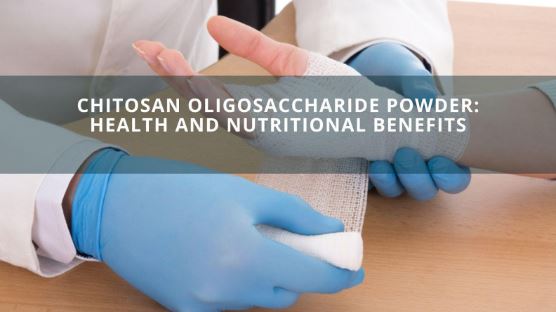Role of Chitosan in Wound Dressings: A Comprehensive Review

Wound management is a critical aspect of healthcare, and the development of effective wound dressings has been the subject of extensive research and innovation.
Chitosan, a natural biopolymer derived from chitin, has emerged as a promising material for wound dressings due to its remarkable properties. This comprehensive review explores the role of chitosan in wound dressings, including its properties, benefits, applications, and recent advancements in the field.
Understanding Wound Dressing

Wounds, whether caused by accidents, surgical procedures, or chronic conditions, require proper care and management to facilitate efficient healing and prevent infection. The choice of wound dressing material plays a pivotal role in this process. In recent years, chitosan has garnered significant attention as a material with immense potential for wound dressings.
Properties of Chitosan
Before delving into its role in wound dressings, it’s essential to understand the unique properties that make medical chitosan an attractive choice for medical applications.
Biocompatibility
Chitosan is derived from chitin, a natural polymer found in the shells of crustaceans, such as shrimp and crabs. Due to its biocompatibility, chitosan exhibits minimal adverse reactions when applied to wounds, making it suitable for a wide range of patients, including those with sensitive skin.
Antimicrobial Activity
One of the standout properties of chitosan is its antimicrobial activity. It can inhibit the growth of various bacteria and fungi, including Staphylococcus aureus and Candida albicans. This property is particularly advantageous in wound management, as it reduces the risk of wound infections, which can significantly impede the healing process.
Hemostatic Properties
Chitosan-based wound dressings also possess hemostatic properties, which means they can help stop bleeding by promoting blood clot formation. This is especially valuable in cases of traumatic wounds or surgeries where excessive bleeding is a concern.
Biodegradability
Chitosan is biodegradable, meaning it breaks down naturally over time. This property is advantageous for wound dressings because it eliminates the need for frequent dressing changes, reducing patient discomfort and the risk of disturbing the wound bed during healing.
Moisture Retention
Chitosan dressings have the ability to retain moisture, creating an optimal environment for wound healing. Proper moisture levels are essential for tissue regeneration, and chitosan helps maintain this balance.
Chitosan-Based Wound Dressings
Chitosan is commonly used in the formulation of wound dressings due to its favorable properties. Chitosan wound dressings come in various forms, each tailored to specific wound types and requirements.
Chitosan Films
Chitosan films are thin, flexible sheets that adhere to the wound’s surface. They provide a protective barrier while allowing for gas exchange, preventing contamination and promoting a moist wound environment. Chitosan films are ideal for superficial wounds and are often used post-surgery.
Chitosan Sponges
Chitosan sponges or foams are highly absorbent and are particularly useful for wounds with heavy exudate (fluid discharge). They help maintain a moist wound environment while effectively absorbing excess fluids. The porous structure of chitosan sponges aids in tissue regeneration.
Chitosan Hydrogels
Chitosan hydrogels are three-dimensional networks that can absorb and retain a significant amount of water. They are suitable for wounds that require constant moisture, such as chronic ulcers. Chitosan hydrogels also offer controlled drug release capabilities, enabling the delivery of medications to the wound site.
Chitosan Nanoparticles
Nanotechnology has allowed for the development of chitosan nanoparticles that can encapsulate therapeutic agents. These nanoparticles can be incorporated into wound dressings to deliver drugs, growth factors, or antimicrobial agents directly to the wound site, enhancing the healing process.
Applications of Chitosan Wound Dressings
The versatility of chitosan-based wound dressings has led to their widespread use in various clinical scenarios.
Acute Wounds
Chitosan dressings are effective for managing acute wounds, such as surgical incisions and traumatic injuries. Their hemostatic properties help control bleeding, while their antimicrobial activity reduces the risk of infection. Chitosan films are often used in these cases due to their ease of application and removal.
Chronic Wounds
Chronic wounds, including diabetic ulcers and pressure sores, can be particularly challenging to treat. Chitosan hydrogels and sponges are preferred choices for these wounds due to their ability to maintain a moist environment and facilitate tissue regeneration. Additionally, chitosan’s antimicrobial properties aid in combating infections commonly associated with chronic wounds.
Burn Wounds
Burn injuries require specialized wound care, and chitosan dressings have shown promise in this regard. Chitosan films and hydrogels can provide a protective barrier over burn wounds, reducing the risk of infection and promoting faster healing. Their ability to manage exudate is especially beneficial in burn wound management.
Surgical Site Infections (SSI) Prevention
Surgical site infections can lead to serious complications post-surgery. Chitosan films applied to surgical incisions have been shown to reduce the incidence of SSIs. The films create a physical barrier against pathogens and release antimicrobial agents, further enhancing their effectiveness.
Recent Advancements in Chitosan-Based Wound Dressings
The field of wound management is continually evolving, and recent advancements in chitosan-based wound dressings have expanded their utility.
Incorporation of Growth Factors
Researchers are exploring the incorporation of growth factors into chitosan wound dressings to accelerate the wound healing process. Growth factors, such as epidermal growth factor (EGF) and platelet-derived growth factor (PDGF), can stimulate cell proliferation and tissue regeneration.
Antioxidant Properties
Chitosan itself possesses antioxidant properties, which can help protect the wound site from oxidative stress, inflammation, and free radical damage. Dressings with enhanced antioxidant capabilities are being developed to further support wound healing.
Smart Dressings
The integration of sensors and monitoring systems into chitosan for wound dressings is another exciting development. Smart dressings can provide real-time data on the wound’s condition, including temperature, moisture levels, and bacterial load. This technology allows for early detection of complications and more personalized wound care.
Drug-Loaded Nanoparticles
The use of chitosan nanoparticles for drug delivery has gained momentum. These nanoparticles can encapsulate various therapeutic agents, including antibiotics, analgesics, and anti-inflammatory drugs, ensuring targeted and sustained release at the wound site.
Challenges and Future Directions
While chitosan-based wound dressings hold immense promise, several challenges and future directions warrant consideration.
Standardization
The development of standardized protocols for chitosan dressing fabrication and application is essential to ensure consistent quality and performance across different products and manufacturers.
Clinical Trials
Further clinical trials and long-term studies are needed to establish the efficacy and safety of chitosan wound dressings in various wound types and patient populations. This will help build a robust evidence base for their widespread adoption.
Cost-Effectiveness
The cost-effectiveness of chitosan-based wound dressings compared to traditional options is a critical factor in their acceptance and accessibility in healthcare settings. Research on cost-effectiveness is crucial to justify their use.
Personalized Wound Care
Advancements in personalized wound care, including the development of customized chitosan dressings based on individual patient characteristics, are an exciting avenue for future research.
Conclusion
Chitosan-based wound dressings offer a compelling solution for wound management. Their biocompatibility, antimicrobial activity, hemostatic properties, and moisture-retaining capabilities make them versatile and effective tools in healthcare. Recent advancements in chitosan-based dressings, including the incorporation of growth factors, antioxidant properties, and smart technologies, indicate a promising future for this field.
As researchers continue to explore the full potential of chitosan in wound management, it is likely that we will see even more innovative applications and improved outcomes for patients. Chitosan’s role in wound dressings is poised to continue evolving, ultimately benefiting individuals in need of effective wound care.
As the field of wound management embraces the potential of chitosan-based dressings, it is imperative to consider reputable manufacturers and suppliers. Among them, Chitolytic stands out as a leading provider of medical-grade chitosans, offering high-quality materials that contribute to the ongoing advancement of wound care solutions.








